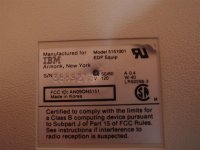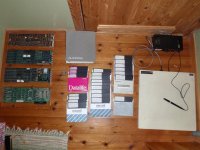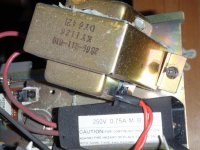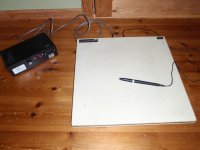per
Veteran Member
Warning, quite a lot of text follows, you don't need to read everything.
Introduction:
About one and a half year ago, forum member Amigaz bought an PC/AT from someone in Germany. The system had previously been used as an advanced video editing system, but unfortunately, it got a disk-crash durning shippment. Because of this, Amigaz decided to part the system into a standard PC/AT configuration (details: http://www.vintage-computer.com/vcforum/showthread.php?13328 ).
I decided to buy the Mono-monitor ( http://www.vintage-computer.com/vcforum/showthread.php?13339 ), and I was offered the items concerning the graphics editing system at the same time. I accepted the offer, but I did not want to ship it due to the fact that a monitor was included. Instead, some friends of mine in Stockholm agreed to keep the items untill I got the time to pick them up.
This easter, I finally got the ability to pick the parts up, and it turns out to be quite some interesting pieces of software/hardware.
Monitor:
A standard IBM 5151, with a "VIDI" sticker rigth above the front IBM logo.
For some reason, it's written 120v on the rear label of it. I can't seem to understand this since it has been used in Europe, and that it doesn't seem to have been connected to a converter. For instance, I do got an converter, but I don't know what I risk running 120v through it IF it expects 240v (Amigaz claimed it was 240v in the post, but I don't know to what degree he tested it, or if he made sure the voltage levels of the AT's PSU output were not regulated down to 120v). Else, it seems to be in very good condition.
See attachement numbered 001 and 002 for details.
Graphics package:
This is the most interesting part. It consist of some software, a manual, and some hardware that is more or less required to operate the software.
The manual describes how to operate the "Aurora/75" and "Aurora/125" video editing systems. The difference between the /75 and /125 is that in the /125 system, the entire system is it's own computer dedicated to just run the Aurora OS and do video editing, while in the /75 system, an AT connected to special hardware is used to emulate the /125 system. Of course, what I got is the /75 system, and it has been distributed by a company called "Vidi".
The disks I got with the system is as follows:
9 disks labeled "Version 3.1 Backup" (numbered)
6 disks labeled "Practice" (numbered)
4 disks labeled "Update 3.1b" (numbered)
1 disk labeled "Venix XFER" (Venix boot disk, needed to restore the backup)
3 disks (problably) containing user-made data
On the hardware side, there are four parts (five if including the IBM MDA). There is an external drawing pad, two quite similar ISA cards, and a third ISA card not that similar to the two first ones. According to the manual, the Aurora OS requires two RGB monitors and the drawing-pad for graphics operation, and a MDA and keyboard for terminal operation. In addition to this, a lot of optional devices are also supported (like camera interfaces and video-tape interfaces).
The main input of the Aurora OS is the drawing-pad and pen. The pen connects to the board along with a seperate powersupply, and the boards connects to the system by standard RS-232 (selectable baud-rate).
There is no doubt that the two quite similar cards are graphics adapters. They both have the same number of RCA connectors, they're both made by "Number 9 computers", and they both uses the NEC D7220(A)D Graphics Processing Unit. The cards does at least do 256-level analog RGB, but I don't know the sync frequencies. There area few differences, though. One of the cards is 8-bit, and labeled "rev6". However, the other card is 16-bit, labeled "rev4", has a daugtherboard with some switches, and a 4-times-bigger/1.25-times-faster framebuffer. The pinout on therse cards are (from the upper RCA): Analog-Red, Analog-Green, Analog-Blue, CS, V, (and problably) H.
The last card is the most interesting piece. It is named "PC-EYE BD", and is made by "Chorus data systems" in 1984. It appears to be a optional video capturing device, and I'm 90% sure the input is supposed to come from a RGB-camera. I am however still unsure if this means that anything outputing analog RGB can be connected to it, and I do not know what RCA contact corresponds to what signal.
Conclusion:
As I see it, The only things I need in order to get this working, is:
It would be really cool if I got this thing to work.
A final note:
Of course, if any of you have any information (even information from old ads) on any of the cards/issues discussed above, feel free to share.
Introduction:
About one and a half year ago, forum member Amigaz bought an PC/AT from someone in Germany. The system had previously been used as an advanced video editing system, but unfortunately, it got a disk-crash durning shippment. Because of this, Amigaz decided to part the system into a standard PC/AT configuration (details: http://www.vintage-computer.com/vcforum/showthread.php?13328 ).
I decided to buy the Mono-monitor ( http://www.vintage-computer.com/vcforum/showthread.php?13339 ), and I was offered the items concerning the graphics editing system at the same time. I accepted the offer, but I did not want to ship it due to the fact that a monitor was included. Instead, some friends of mine in Stockholm agreed to keep the items untill I got the time to pick them up.
This easter, I finally got the ability to pick the parts up, and it turns out to be quite some interesting pieces of software/hardware.
Monitor:
A standard IBM 5151, with a "VIDI" sticker rigth above the front IBM logo.
For some reason, it's written 120v on the rear label of it. I can't seem to understand this since it has been used in Europe, and that it doesn't seem to have been connected to a converter. For instance, I do got an converter, but I don't know what I risk running 120v through it IF it expects 240v (Amigaz claimed it was 240v in the post, but I don't know to what degree he tested it, or if he made sure the voltage levels of the AT's PSU output were not regulated down to 120v). Else, it seems to be in very good condition.
See attachement numbered 001 and 002 for details.
Graphics package:
This is the most interesting part. It consist of some software, a manual, and some hardware that is more or less required to operate the software.
The manual describes how to operate the "Aurora/75" and "Aurora/125" video editing systems. The difference between the /75 and /125 is that in the /125 system, the entire system is it's own computer dedicated to just run the Aurora OS and do video editing, while in the /75 system, an AT connected to special hardware is used to emulate the /125 system. Of course, what I got is the /75 system, and it has been distributed by a company called "Vidi".
The disks I got with the system is as follows:
9 disks labeled "Version 3.1 Backup" (numbered)
6 disks labeled "Practice" (numbered)
4 disks labeled "Update 3.1b" (numbered)
1 disk labeled "Venix XFER" (Venix boot disk, needed to restore the backup)
3 disks (problably) containing user-made data
On the hardware side, there are four parts (five if including the IBM MDA). There is an external drawing pad, two quite similar ISA cards, and a third ISA card not that similar to the two first ones. According to the manual, the Aurora OS requires two RGB monitors and the drawing-pad for graphics operation, and a MDA and keyboard for terminal operation. In addition to this, a lot of optional devices are also supported (like camera interfaces and video-tape interfaces).
The main input of the Aurora OS is the drawing-pad and pen. The pen connects to the board along with a seperate powersupply, and the boards connects to the system by standard RS-232 (selectable baud-rate).
There is no doubt that the two quite similar cards are graphics adapters. They both have the same number of RCA connectors, they're both made by "Number 9 computers", and they both uses the NEC D7220(A)D Graphics Processing Unit. The cards does at least do 256-level analog RGB, but I don't know the sync frequencies. There area few differences, though. One of the cards is 8-bit, and labeled "rev6". However, the other card is 16-bit, labeled "rev4", has a daugtherboard with some switches, and a 4-times-bigger/1.25-times-faster framebuffer. The pinout on therse cards are (from the upper RCA): Analog-Red, Analog-Green, Analog-Blue, CS, V, (and problably) H.
The last card is the most interesting piece. It is named "PC-EYE BD", and is made by "Chorus data systems" in 1984. It appears to be a optional video capturing device, and I'm 90% sure the input is supposed to come from a RGB-camera. I am however still unsure if this means that anything outputing analog RGB can be connected to it, and I do not know what RCA contact corresponds to what signal.
Conclusion:
As I see it, The only things I need in order to get this working, is:
- An AT-compatible computer to put it all in (perhaps my 486 will work)
- A pile of RCA (m) to BNC (m) cables
- Perhaps another VGA monitor with BNC inputs
It would be really cool if I got this thing to work.
A final note:
Of course, if any of you have any information (even information from old ads) on any of the cards/issues discussed above, feel free to share.
Attachments
Last edited:





